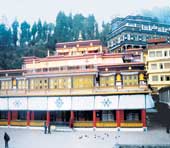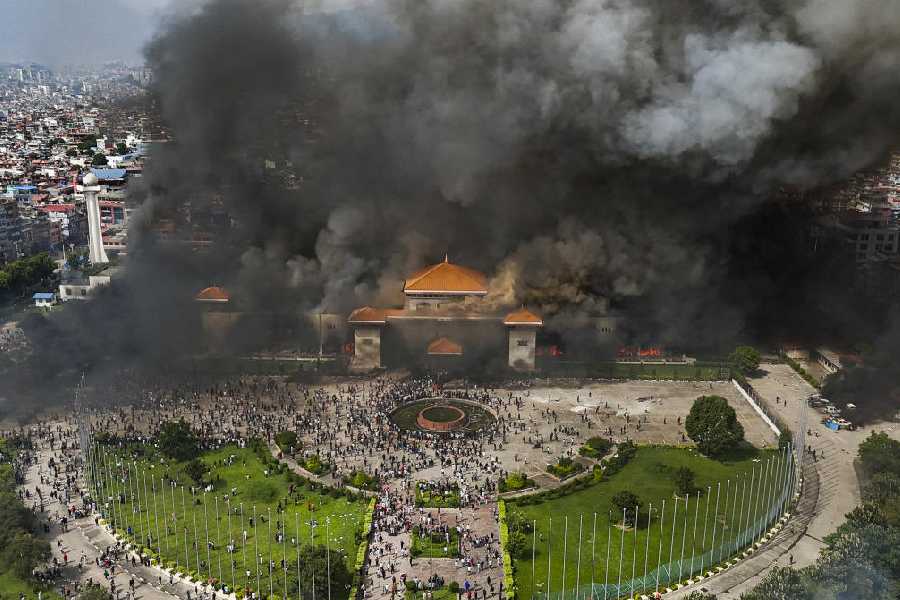 |
Gangtok or “hill top”, spread over a ridge at 6,500 ft above sea level, is the capital city of the 22nd state of India — Sikkim. Sikkim derives its name from the word “sukhim” (peace and happiness). The Tibetans refer to it by the name “Denjong” (the hidden valley of rice). It is a small mountainous state bounded by Tibet on the north, Bhutan in the east, Nepal in the west and West Bengal in the south.
The four-hour ride to Gangtok from Bagdogra airport (45 minutes by plane from Calcutta) is thrilling. The swift Teesta clears her serpentine track through slopes of bamboo and wild banana trees that rise to conifers towering like cathedral pillars and orchids.
Gangtok and its surrounding areas are famous for exotic flowers that bloom throughout the year. Between April to June, rhododendrons, primulas, gentians, blue poppies and over 250 types of orchids are in their full glory. Between October and December, chrysanthemums and some varieties of orchids fascinate visitors. The mighty Kanchenjunga, with its mantle of snow, overlooks everything like a protective deity.
Any other part of the region is as beautiful as Gangtok; it is the monasteries and the Kanchenjunga that lend the town its special flavour. Just 24 km from Gangtok is Rumtek, the largest monastery in the state, considered the mainstay of Buddhist culture. The monastery houses wonderful wall hangings, paintings and thangkas. There is also a lovely prayer hall.
The original gompha (monastery), built in 1730 by the ninth karmapa, was accidentally burnt down in a bonfire in 1960. The 16th karmapa, Giyaloya, rebuilt the monastery. The Nalanda Institute is just behind the gompha.
The festivals of Sikkim are very colourful. The Tsechu dance is held in the Rumtek monastery in summer. Kagyat is another fascinating dance, performed by Buddhist monks on different occasions. The Sikkim government organises folk dances for tourist groups during the holiday season.
Enchey Monastery, established in 1840, is famous for its Chaam dance in December. This colourful festival is only held in select ancient monasteries. Only lamas are allowed to take part in Chaam, also known as the mask dance.
Deer Park, Maharaja Chogyal Palace, Institute of Cottage Industries, Research Institute of Tibetology, Orchid Sanctuary, Ganeshtok, Hanumantok and Tashi View Point are some other points of tourist attraction in Gangtok.
Beside the Sikkim Assembly is the tranquil Namnang View Point from where one can cast an eye on the wide open valley. The cable car ride to Deorali is great fun not only for kids but also for grown-ups.
Saramsa Garden, 14 km from the town, is home to nearly 400 types of orchids. Some of these are rare varieties. Medicinal plants are also cultivated under the supervision of the forest department. Lal Bazaar is the largest market of the state and a major tourist draw.
Gangtok is the gateway to east and north-east Sikkim. You may want to travel to Yumthang, Lachen and Lachung. You can also drive to Nathu La at a height of 14,500 ft near the India-China border. Stop over at Tsango Lake, on the way back. The temple of the late Harbhajan Singh (known as Baba Temple) is an added attraction.
Gangtok is the land of hikers, trekkers, mountaineers, mountain-lovers, bird-watchers and butterfly-collectors but attracts hordes of common tourists, who want to get away from the daily grind to the “land of the lost horizon”. In timeless Sikkim, sheltered by a snowy deity, Gangtok blooms.
Trip tips
The nearest airport is Bagdogra and the nearest railway station is New Jalpaiguri. There are regular buses from Siliguri to Gangtok apart from taxis. Other than the Sikkim government’s tourist lodge, there are hotels and holiday homes to suit every budget.











